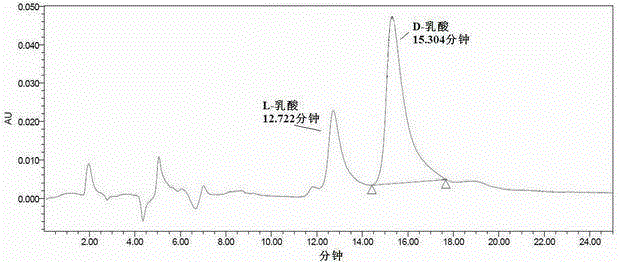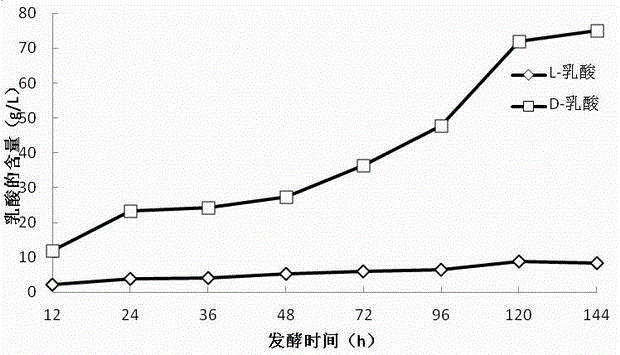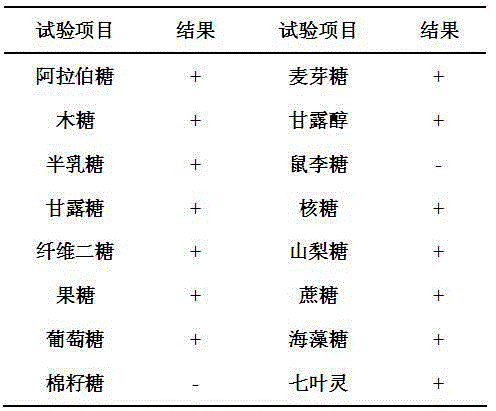Lactobacillus and method for producing D-lactic acid by fermenting using lactobacillus
A kind of Lactobacillus and lactic acid technology, applied in the field of Lactobacillus and utilizing its fermentation to produce D-lactic acid, can solve the problems such as not involving the application of Lactobacillus pentosus, and achieve the effect of promoting nutritional needs
- Summary
- Abstract
- Description
- Claims
- Application Information
AI Technical Summary
Problems solved by technology
Method used
Image
Examples
Embodiment 1
[0042] (1) Put 0.1 g of lyophilized powder of Lactobacillus DMDL9010 into 5 mL of seed medium, and culture it statically at 30°C for 24 hours to make the first seed liquid;
[0043] (2) Put the first activation solution into the seed medium at a volume ratio of 10:100, and culture it statically at 30°C for 24 hours to make the second seed solution;
[0044] (3) Put the second activation solution into the seed medium at a volume ratio of 10:100, and culture it statically at 30°C for 24 hours to make the third seed solution;
[0045] (4) Put the third seed solution into the fermentation medium at a volume ratio of 5:100, and cultivate it at 30°C in a fermenter with a stirring speed of 100~150rpm. Add a total of 50g / L of sterilized CaCO in 5 times 3 , the fermentation time is 144h.
[0046] The formula of the seed medium is: glucose 20g / L, peptone 10g / L, beef extract 10g / L, yeast powder 5g / L, sodium acetate 2g / L, triamine citrate 2g / L, Tween 80 1mL / L, MgSO 4 .7H 2 O 0.2 g / L,...
Embodiment 2
[0054] (1) Place 0.2 g of lyophilized powder of Lactobacillus DMDL9010 in 6 mL of seed medium, and culture it statically at 35°C for 20 hours to make the first seed liquid;
[0055] (2) Put the first activation solution into the seed medium at a ratio of 10:100 by volume, and culture it statically at 35°C for 24 hours to make the second seed solution;
[0056] (3) Put the second activation solution into the seed medium at a ratio of 10:100 by volume, and culture it statically at 35°C for 24 hours to make the third seed solution;
[0057] (4) Put the third seed liquid into the fermentation medium with a volume ratio of 8:100, and cultivate it at 35°C in a fermenter with a stirring speed of 100~150rpm. Add a total of 20g / L of sterilized CaCO2 in 2 times 3 After every 24 hours of fermentation, sterilized 40% (wt) ammonia water was added at a flow rate of 1.0ml / min, the pH was adjusted to 6.8, and the fermentation time was 120 hours.
[0058] The formula of the seed medium is: g...
Embodiment 3
[0064] (1) Put 0.3 g of lyophilized powder of Lactobacillus DMDL9010 into 7 mL of seed medium, and culture it statically at 30°C for 24 hours to make the first seed liquid;
[0065] (2) Put the first activation solution into the seed medium at a volume ratio of 10:100, and culture it statically at 30°C for 24 hours to make the second seed solution;
[0066] (3) Put the second activation solution into the seed medium at a volume ratio of 10:100, and culture it statically at 30°C for 24 hours to make the third seed solution;
[0067] (4) Put the third seed solution into the fermentation medium at a volume ratio of 5:100, and cultivate it at 30°C in a fermenter with a stirring speed of 100~150rpm. Add a total of 30g / L of sterilized Ca(OH) in 3 times 2 After every 24 hours of fermentation, sterilized 40% (wt) NaOH solution was added at a flow rate of 1.0 ml / min to adjust the pH to 7.0, and the fermentation time was 144 hours.
[0068] The formula of the seed medium is: glucose 1...
PUM
| Property | Measurement | Unit |
|---|---|---|
| optical purity | aaaaa | aaaaa |
| optical purity | aaaaa | aaaaa |
| optical purity | aaaaa | aaaaa |
Abstract
Description
Claims
Application Information
 Login to View More
Login to View More - R&D
- Intellectual Property
- Life Sciences
- Materials
- Tech Scout
- Unparalleled Data Quality
- Higher Quality Content
- 60% Fewer Hallucinations
Browse by: Latest US Patents, China's latest patents, Technical Efficacy Thesaurus, Application Domain, Technology Topic, Popular Technical Reports.
© 2025 PatSnap. All rights reserved.Legal|Privacy policy|Modern Slavery Act Transparency Statement|Sitemap|About US| Contact US: help@patsnap.com



